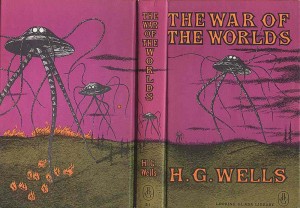“The Martian Lord of Creation”
“Those who have never seen a living Martian can scarcely imagine the strange horror of its appearance…. Even at this first encounter, this first glimpse, I was overcome with disgust and dread.” —H.G. Wells, War of the Worlds, 1898.Wells wasn’t alone in thinking Red Planet Dwellers would be a comp…

"Those who have never seen a living Martian can scarcely imagine the strange horror of its appearance.... Even at this first encounter, this first glimpse, I was overcome with disgust and dread." —H.G. Wells, War of the Worlds, 1898.
Wells wasn't alone in thinking Red Planet Dwellers would be a complete fright to behold. Charles Warner wrote in an 1896 edition of Harper's that, " may be in the shape of a single wheel, able to roll easily anywhere, or in that of a sphere, or of a cigar.... The Martian lord of creation may have wings, he may be a gigantic insect, or a noble sort of eagle..... He may, indeed, have four dimensions instead of three, and instead of five senses a dozen, and among them common-sense." Yeah, baby, Yeah!

The American astronomer Garrett Serviss wrote about Martian superiority circa 1905: "The Martian intelligences might look upon us as we look upon monkeys in a menagerie, and their learned doctors might say: 'See what we were like once!... Give them time, and place them amid our surroundings, and who knows but that they might develop electro-magnetic vision, electro-magnetic hearing and electro-magnetic muscular control? They might even discover the secret of using inter-atomic energy, which has saved us.' "
An anonymous article appeared in an 1886 issue of the British magazine Chamber's, speculating that Martians "would be about fourteen feet high on the average.... We should, therefore, expect to find that the Martialites have executed large engineering works; perhaps also their telescopes are much superior to ours, and we have been objects of interest for their observers."
The examples above were gathered by K. Maria D. Lane, a geography professor at the University of New Mexico, for her new book Geographies of Mars: Seeing and Knowing the Red Planet (University of Chicago Press, January 2011). Lane argues that at the turn of the 20th century, the moment in which the public became obsessed with the inhabitants of Mars, European imperialism and American expansionism "produced an intellectual and social climate in which the view of Mars as an arid, dying, irrigated world peopled by unfathomably advanced beings was really the only interpretation of Mars observations that could plausibly been accepted by large numbers of Western scientists, writers, and audiences."
For a Mars timeline stretching from 1700 to 1959, visit The Planetary Society's page, which includes a blurb about the 1910 Thomas Edison-produced four-minute film, A Trip to Mars: "A famous professor discovers that when he mixes two magical powders, he has the power to reverse gravity. As he tests the concoction, some of the powder falls on him, and he is lifted up and flies through the sky until he finally falls on the surface of Mars. He escapes some gnarly-limbed trees only to fall over a ridge and land on the lip of a giant Martian."